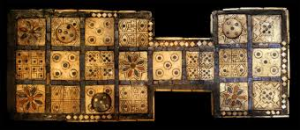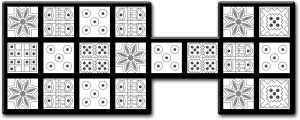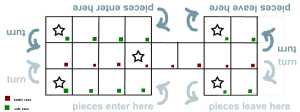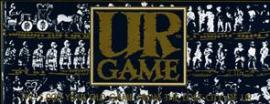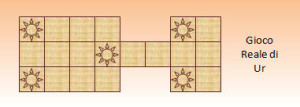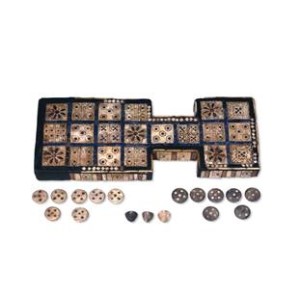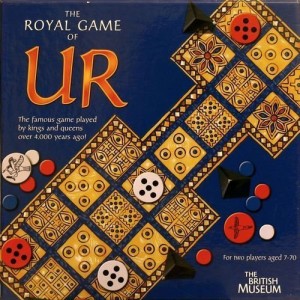Ur Game
The Ur Game, also known as “The Game of Twenty Squares”, was found by Leonard Woolley during the excavations of the Royal Cemetery of Ur in the first decades of the XX century.
The renowned model of this gameboard, today preserved in the British Museum in London, is only one of several with a similiar layout found bu Woolley during his excavations in Ur. It is, undoubtedly, the most completed and best preserved find of this type. Althought wood had deteriorated over time, the inlay of shell, red limestone, carnelian and lapis lazuli have been preserved so well to allow a close and loyal reconstruction of the object.
The table has been datated between 2600 and 2400 B.C..
It is considered one the oldest examples of gameboard (some describe it as the predecessor of the moder backgammon!).
- Description of the gameboard
The table il composed by a grid of 8×3 squares, which is missing two boxes for each long side, for a total of twenty small squares.
The boxes are variously and richly decorated: five squares are decorated with flowers rosettes, another five with a decoration like “eyes” and five more squares with dots enclosed in small circles. In the other boxes there are similiar patterns like geometric drawings, dots and circles.
- How to play?
Many have been the hypotheses of scholars about the true regulation of this game. There is still no absolute certainty, but it seems to prevail the theory advanced by Irving Finkel in the early Eighties on the basis of the interpretation of two tablets, now preserved in the British Museum: to compete should be only two players, both engaged in a sort of “race game” to bring their pieces from side to side of the table. According to Finkel it was a game of race and gambling. The counters were raised according to the number that came out when the players threw the dice.
Each player competed to bring as soon as possible its piece outside of each box and, if a counter landed upon a square occupied by an opposing counter, the counter landed upon was sent off the board and had to start again from the beginning. It also seems that the boxes with flowers rosettes were lucky, giving an award to the player who was above the lucky square or immunity to the one who was attacked by opponent’s piece.
Inside the tombs of Ur dice of different shapes were also found, an element that contributes to the thesis of the launch of these to move the pieces on the table: it also seems that the launch of the dice decided which of the two players had to start the game.
- Circulation of the game
This type of game spread widely beyond the borders of Ancient Mesopotamia. We have examples from Ancient Egypt, but also reproductions, more or less evolve,d discovered in Iran, Syria, Cyprus, Crete and India.
Today we can find nice tutorial on YouTube that explain how to use the gameboard.
We also have the chance to play online on the British Museum’s website or you can directly buy the boardgame online, so you can enjoy it comfortably at home, going over in a “desperate race to the victory” the boxes of the ancient game-table of the Sumerians.
———————————————————————————————————–
Il gioco di Ur, chiamato anche “gioco delle venti caselle”, venne rinvenuto all’interno del Cimitero Reale durante gli scavi condotti da Leonard Woolley ad Ur nei primi decenni del XX secolo.
Il famoso esemplare di questa tavola, oggi conservato al British Museum di Londra, è solo uno dei tanti rinvenuti da Wolley durante le campagne di scavo ad Ur. E’ senza dubbio il reperto più completo e meglio conservato. Nonostante il legno si fosse deteriorato nel corso del tempo, gli intarsi in conchiglia, calcare rosso, corniola e lapislazuli si sono conservati talmente bene da permettere una fedele ricostruzione dell’oggetto.
Il reperto è stato datato fra il 2600 e il 2300 a.C.
È considerato uno dei più antichi esempi di tavola da gioco (alcuni lo descrivono come il predecessore del moderno backgammon!)
- Descrizione
Il gioco è composto da una tavola di 8×3 caselle, a cui mancano due caselle per ogni lato lungo, per un totale di venti piccoli riquadri.
Le caselle sono variamente e riccamente decorate: cinque riquadri sono decorati da rosette, altri cinque da una decorazione ad “occhi” e ancora cinque da punti racchiusi in piccole circonferenze. Nel resto delle caselle ci sono altri disegni geometrici, punti e cerchi.
- Come si gioca?
Molte sono state le ipotesi degli studiosi riguardo il vero regolamento di questo gioco. Non si hanno ancora certezze assolute, tuttavia sembra prevalere la tesi avanzata da Irving Finkel all’inizio degli anni Ottanta sulla base dell’interpretazione di due tavolette conservate al British Museum: a competere dovevano essere due giocatori, entrambi impegnati in un “race game” per portare le loro pedine da un lato all’altro della tavola. Secondo Finkel si tratta infatti di un gioco di percorso e di azzardo. Le pedine venivano mosse a seconda del numero che usciva nel momento in cui i giocatori lanciavano i dadi. Ogni giocatore gareggiava per portare il prima possibile la propria pedina all’esterno di ogni casella e, qualora calpestasse la pedina avversaria, l’altro giocatore era costretto a ricominciare da capo. Sembra inoltre che le caselle con le rosette fossero fortunate, dando diritto ad una posta al giocatore che ci si trovava sopra o all’immunità di colui che veniva aggredito dalla pedina avversaria.
All’interno delle tombe di Ur sono stati inoltre rinvenuti dei dadi di diverse forme, elemento che contribuisce alla teoria del lancio di questi per far muovere le pedine sul campo: sembra anche che il lancio dei dadi decidesse chi dei due giocatori dovesse iniziare a giocare.
- Diffusione
Questa tipologia di gioco si diffuse ampiamente anche oltre i confini dell’Antica Mesopotamia. Abbiamo esempi provenienti dall’Antico Egitto, ma anche riproduzioni più o meno evolute scoperte in Iran, in Siria, a Cipro, a Creta fino in India.
Oggi possiamo trovare simpatici tutorial su youtube che spiegano come usare la tavola da gioco. Inoltre abbiamo la possibilità di giocare online sul sito del British Museum oppure potete direttamente acquistare il gioco da tavola per potervi divertire comodamente in casa, ripercorrendo in una “disperata corsa alla vittoria” le caselle dell’antica tavola da gioco dei Sumeri.
